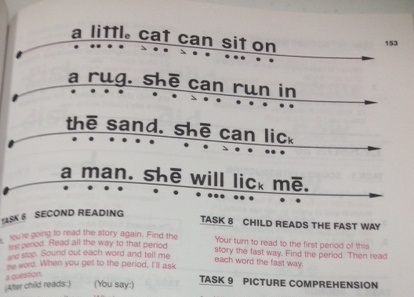Teach Your Child to Read in a 100 Easy Lessons
I've recently been trying to like the book Teach Your Child To Read In 100 Easy Lessons, co-authored by Direct Instruction guru Siegfried Engelmann.
I bought this book years ago, but I confess I've never used it.
It just always looked too strange and difficult, with its detailed scripts, funny-looking dots, arrows and diacritics and nothing that looks much like a beginner's reader or a meaningful writing opportunity. Here's what the text for learners to read looks like:

Each lesson in the book contains scripts that the parent is intended to say verbatim, and it tells you precisely what to do (touch this, point to that etc.) every step of the way.
In Lesson 4, we come to this:

The vowel is apparently meant to be pronounced as in the word "cat", not as in the word "ha". My problem: we don't have "a" as in "cat" at the end of words in English. It's a "checked" vowel and must be followed by a consonant. If the letter "a" is at the end of the word, the sound is usually "a" as in "Ma", "Pa" and "tra la la". So I'm just not going to teach learners to say "sa" with "a" as in "cat", sorry. It's linguistically incorrect.
Also, this book is from the US, where they say "r" after vowels. Here in Australia, we don't, so I'm not going to teach those bits either.
However, I know that this and other Direct Instruction programs are the ones that have had the best literacy results when tested by large-scale scientific blowtorches, so I've always felt a bit guilty about not using them.
I have never been able to imagine getting my students to cooperate for long with these lessons, or wait around for me to check the script, if I hadn't managed to memorise it before the session (it's a long book, lesson 100 starts on page 389). I work with some pretty naughty and fed-up kids, and don't have a lot of lesson-memorising time, and I'm sure you don't either.
As well as Teach Your Child to Read In 100 Easy Lessons, I've been looking at the Corrective Reading Word Attack Basics program, also co-authored by Engelmann. I've come to the conclusion that I use much the same logic and strategies, but that I need something that looks more interesting and meaningful, and sticks mostly to normal-looking text.

As you can see from the photo above, the Word Attack Basics program also teaches some non-words, and while I think these are useful for testing purposes, I'm only interested in teaching real words. Most of my learners are already far enough behind on vocabulary, without wasting time learning words they won't use.
However, I recently went to the Learning Difficulties Australia Annual General Meeting and listened to a talk by Dr Rhonda Farkota about Direct Instruction, which included part of an old video clip of Siegfriend Engelmann asking a bunch of disadvantaged six-year-olds maths questions. They knew an awful lot of maths for such little kids. I wish some of the much bigger kids I know were half as numerate.
Here's what the video looks like, and if you have a spare 13 minutes, please watch it yourself on Youtube:
This video makes me laugh out loud in places. Engelmann behaves like a cross between a quiz show host and a call-and-response preacher.
The kids sit forward on their chairs, shouting out answers, counting on their fingers and whispering workings-out to themselves under their breaths, and occasionally leaping to their feet to correct his errors on the board.
They squeal, clap their hands and giggle. Don't miss their answer to his question, "What happens when you think?", at about minute 9. Priceless.
This is not the dry, repetitive sort of teaching I imagined while reading "Teach Your Child To Read In 100 Easy Lessons", but if this is how Direct Instruction is delivered, then I think the delivery is part of the secret.
When I imagine Teach Your Child To Read In 100 Easy Lessons delivered at warp speed by a quiz show host-preacher-teacher, it doesn't seem quite so dull and difficult after all.
So if you're a parent who isn't confident about teaching your child to read, and the key things you want are a detailed script to follow plus the knowledge that your program has been scientifically tested, plus you're prepared to set a cracking pace, overlook things like "sa" and adopt an American accent whenever you see a word-final "r", "Teach Your Child To Read In 100 Easy Lessons" might be for you.
Source: https://www.spelfabet.com.au/2013/10/teach-your-child-to-read-in-100-easy-lessons/